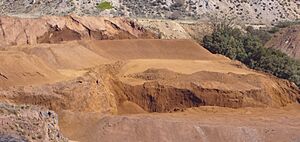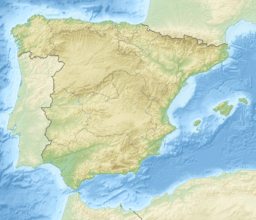Sierra Menera facts for kids
Quick facts for kids Sierra Menera |
|
|---|---|

The Castle of Peracense built on a ridge in Sierra Menera
|
|
| Highest point | |
| Peak | Monte de San Ginés |
| Elevation | 1,601 m (5,253 ft) |
| Dimensions | |
| Length | 29 km (18 mi) NNW/SSE |
| Width | 5.3 km (3.3 mi) ENE/WSW |
| Geography | |
| Location | Jiloca, Comunidad de Teruel, Sierra de Albarracín, Aragon Guadalajara, Castile-La Mancha |
| Parent range | Iberian System, SW zone |
| Geology | |
| Age of rock | Ordovician & Silurian |
| Type of rock | Conglomerate, clay |
| Climbing | |
| Easiest route | From the towns of Ojos Negros or Villar del Salz |
The Sierra Menera is a mountain range in Spain. It is about 31 kilometers (19 miles) long. This range is part of the Iberian System, a large mountain system in the southwestern part of the country.
The Sierra Menera stretches across different areas. It is found in parts of Aragon, including the regions of Sierra de Albarracín, Jiloca, and Comunidad de Teruel. It also reaches into the Province of Guadalajara in Castile-La Mancha on its western side.
You can see the Castle of Peracense standing high on a ridge in the southern part of the range. There's also a spot called Mirador de la Marajosa. From here, you can enjoy amazing views of the mountains and valleys around you. You might also spot aerogenerators, which are like giant wind turbines, on some of the mountain ridges.
Contents
Exploring Sierra Menera's Landscape
The main part of the Sierra Menera runs from the northwest to the southeast. It is not as tall or noticeable as some other mountain ranges in the Iberian System.
Water Flow and Basins
The Sierra Menera is important for water. It acts like a natural wall that divides where water flows. Rainwater on the eastern side flows into rivers that eventually reach the Mediterranean Sea. Water on the western side flows into rivers that go towards the Atlantic Ocean. Some water in the northern part of the range does not flow out to the sea at all. Instead, it collects in the Laguna de Gallocanta basin, which is a large lake.
Highest Points of the Range
The highest point in the Sierra Menera is a peak called Monte de San Ginés. It stands 1,601 meters (5,253 feet) tall. Another important peak is Mojón Alto, which is 1,591 meters (5,220 feet) high.
A Look into Sierra Menera's Past
The name "Sierra Menera" comes from the Spanish word for "ore." This is because the mountains are rich in iron ore. People have been digging for iron here for a very long time.

Mining History and Railways
Ancient people like the Celtiberians and later the Romans mined iron in these mountains. Mining continued all the way until the late 1900s.
In 1903, a company called Compañía Minera de Sierra Menera S. A. built a special railway line. This railway was 200 kilometers (124 miles) long! It was used to carry the iron ore from the mountains all the way to the harbor of Sagunto. This was the longest private railway line owned by a company in Europe at that time.
The company also had a large factory in Sagunto. This factory had a blast furnace to process the iron. In the 1970s, they added a plant to make iron pellets and a long pier for ships.

Environmental Impact of Mining
Over many centuries, the Sierra Menera range was greatly affected by mining. The mining methods used were not always good for the environment. There are still many tons of leftover rock and waste, called slag, scattered around the mountains. This waste can pollute the soil and the water underground.
From the mid-1900s, large-scale open-pit mining made the problems even worse. This type of mining digs huge holes in the ground, causing a lot of damage to the land in large mountain areas.
End of an Era
The iron processing factories in Sagunto stopped working in 1984. Then, in 1987, the Sierra Menera mining company went out of business. This meant the mines and all their related facilities closed down.
The town of Ojos Negros, which relied heavily on the mines, faced a big problem. Many people lost their jobs. As a result, the town's population dropped sharply. It went from about 3,000 people in the 20th century to only 560 people by 2010.
When the mines closed, there were no clear rules to make the mining company fix the environmental damage they had caused. The Spanish Mining Law from 1973 did not include rules about how mining affects the environment.
See also
 In Spanish: Sierra Menera para niños
In Spanish: Sierra Menera para niños
- Mountains of Aragon
- Ojos Negros


